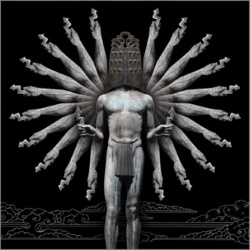Cittamātra as Conventional Truth from Śāntarakṣita to Mipham
Jay L Garfield
Smith College
University of Melbourne
Central University of Tibetan Studies
1. Introduction
Śāntarakṣita is best known for his synthesis of the apparently conflicting schools of Madhyamaka and Cittamātra in his Madhyamakālaṃkāra, or Ornament of the Middle Way. (Blumenthal 2004) In that text, he famously argues that while [[Wikipedia:Cittamātra|Cittamātra]] is true conventionally, Madhyamaka reveals the ultimate truth. Hence the rubric of the two truths, a familiar device for reconciling apparent contradictions in Buddhist doctrine, used since the Pāli canon, comes to the rescue once again, demonstrating that even Mahāyāna schools whose proponents had been debating vigorously for at least two centuries could be reconciled.
So much is agreed upon by all scholars, canonical or modern. There is no consensus, however, regarding how to understand that synthesis, or whether it is successful. Is the sense in which Śāntarakṣita wants us to take Cittamātra seriously merely provisional? Is it to be abandoned for the Madhyamaka view by an advanced practitioner? In this case, this is hardly a synthesis; it is a refutation with a consolation prize, the award of a silver medal to the Cittamātra position and gold to Madhyamaka. Or, on the other hand, is Cittamātra meant to be maintained along with Madhyamaka, respecting the unity of the two truths? In this case, work must be done to demonstrate how two apparently contradictory ontological doctrines can be reconciled. In order to answer these
questions, however, we must also ask how Śāntarakṣita understands Cittamātra in the first place
- Thanks to Nalini Bhushan and Elizabeth Napper for valuable comments on earlier drafts. Thanks especially to Douglas Duckworth and to Thomas Doctor for extensive discussion of these issues and for extensive comments on earlier drafts.
I think that Sāntarakṣita has hit upon some important insights in his synthesis and that we can make good sense of it as a genuine synthesis. But defending it as a genuine synthesis requires us in turn to read Cittamātra phenomenologically instead of idealistically.
When we read it in that way, we discover, as Mipham did, surprising implications regarding the epistemology of introspection and self-knowledge. These implications in turn vindicate certain important dGelugs ideas on these matters, and force us to think hard about such matters dear to Sāntrarakṣita’s heart as svasaṃvedana/rang rig (reflexive awareness, or self-awareness).
I begin by considering the standard dGelugs pa reading of Śāntarakṣita’s synthesis and the problems it raises. I then suggest an alternative reading of Cittamātra and show that this understanding paves the way for a more sensible reading of Madhyamakālaṃkāra. I then turn to a detailed examination of Ju Mipham Rinpoche’s commentary on the central verses of Madhyamakālaṃkārawhere Śāntarakṣita takes on this issue, and explore Mipham’s understanding of what it is to take the mind to be merely conventionally existent. I conclude with a discussion of the implications of this reading of Śāntarakṣita for the philosophy of mind and the epistemology of self-knowledge.
2. The Siddhanta Reading and the Problem
In the dGelugs lineage, as reflected in the commentary of rGyal tshab rje, and in the sgrub mtha’s of lCang skya and 'Jam dbyangs bzhad pa, there is a straightforward way of understanding what Śāntarakṣita is up to in Madhyamakālaṃkārawhen he defends Cittamātra as conventional truth and Madhyamaka as ultimate truth. Conventional truth is, as Nāgārjuna notes, the necessary stepping stone to ultimate truth. And, as Candrakīrti notes, conventional truth is always deceptive. Now, if Madhyamaka is taken to be the authoritative doctrine regarding ultimate truth, and if a Siddhanta framework in which Cittamātra is the penultimate doctrine on the way to Madhyamaka is taken for granted, then it is natural to take Cittamātra as the (albeit deceptive) conventional truth that is the stepping stone to the ultimate truth revealed in Madhyamaka.
In the following verses towards the end of Madhyamakālaṃkāra, Śāntarakṣita invites such a reading
92. On the basis of Cittamātra,
One should understand the absence of external objects. On the basis of our system,
One should understand that there is also a complete absence of self.
93. Whoever rides the chariot of these two systems.
Guiding them with the reins of logic, Will thereby attain the goal,
The realization of the Mahāyāna itself.1
But rGyal tshab rje’s (1999) incisive comments on these verses should us pause, for they suggest a much more interesting, more radical possibility:
Consider all phenomena comprised under causes and effects. They are not substantially different from consciousness. This is because they exist in virtue of being experienced through authoritative perception. This entailment is valid because given this premise, they necessarily exist substantially as consciousness. These phenomena should be understood conventionally in this way as merely mind, in virtue of lacking any external reality. But ultimately, even mind does not exist. For ultimately, it has neither a singular nor a manifold nature. [599]
rGyal tshab rejects the inconsistency of Cittamātra—at least as it is deployed by Śāntarakṣita—with Madhyamaka. The former, he indicates gives us an analysis of our experience of the natural world (“all phenomena comprised under causes and effects”) as known to us only through consciousness; the latter shows us that neither object nor subject exists ultimately; there is no contrast possible between their ontological status. This is an apposite development of Śāntarakṣita’s insight. Inasmuch as the world we experience is only a world delivered by our consciousness, nothing we immediately experience can be substantially different from that consciousness. But that non-difference from consciousness does not in the end give consciousness a privileged position; both the subject and object side are ultimately known in the same way—through perceptual and conceptual mediation—and exist in the same way—as empty of intrinsic identity.
This apparently irenic reading has one important hermeneutical virtue. It explains the continuity between Cittamātra thought read as a kind of idealism with the more realistic Madhyamaka, and does so, paradoxically, by showing how the more thoroughgoing antirealism of Madhyamaka in the end undermines the view that mind has a special
1 Tibetan text in Blumenthal. All translations are my own.
ontological status. This reading, for all of its virtues, nonetheless faces a massive hermeneutical problem. Conventional truth, on a dGe lugs reading of Madhyamaka—a reading that is faithful to Candrakīrti’s exposition (Cowherds 2010)—is supposed to be truth as ordinary people take it to be, the world as we naively take up with it. So, on this reading of Śāntarakṣita’s synthesis, ordinary people are idealists, and experience the world as illusory. Only when they become Mādhyamikas on this view do they come to accept the reality of external objects. As a piece of philosophical anthropology, this seems simply insane. If we are to take Śāntarakṣita’s claim that Cittamātra captures conventional truth seriously, and if we understand conventional truth as, say, Candrakīrti understands it, we cannot also take him, as rGyal tshab and other dGe lugs pa
commentators do, to read Cittamātra idealistically.2
Now it is natural that dGe lugs pa commentators do accept and attribute to Śāntarakṣita an idealistic reading of Cittamātra. For one thing, they read early Cittamātra texts through the commentaries of Sthiramati, who, taking Vasubandhu’s Trimṣika-kārikā and the Vimśatika as authoritative, certainly adopted that reading. And for another, they read Madhyamaka polemics against Cittamātra through Candrakīrti, who in Madhyamkāvatāra attacks Cittamātra as idealist.3 And this is all hermeneutically reasonable. But there was another strain of Cittamātra thought from the beginning, represented in Vasubandhu’s Trisvabhāvanirdeśa and in Asaṇga’s Bodhisattva bhūmi
and in a host of other texts that Śāntarakṣita might have taken more seriously. It is to that phenomenological reading that we now turn
2 This is not to say that conventional truth is whatever ordinary people take it to be. As theC owherds argue (2010) there is a difference between conventional truth and conventional falsehood, and the epistemic conventions that govern conventional truth enable sophisticated and often surprising elaborations and refinement of conventional truth. But it is still at least highly implausible that any such refinement would lead to idealism of this kind.
3 And, of course, their understanding of the Madhyamaka position on the two truths relies directly on Candrakīrti’s presentation.
3. A Phenomenological reading of Cittamātra
Towards the end of Trisvabhāvanirdeśa, (Garfield 2001) Vasubandhu introduces the simile of the elephant conjured in a roadside magic show4 to illustrate the relation of mind to its objects:
27. Like an elephant that appears
Through the power of a magician’s mantra— Only the percepts appears;
The elephant is completely nonexistent.
28. The imagined nature is the elephant;
The other-dependent nature is the visual representation; The non-existence of the elephant therein
Is explained to be the consummate.
29. Through the root consciousness
The nonexistent duality appears.
But since the duality is completely non-existent, There is only a representation.
30. The root consciousness is like the mantra.
Reality can be compared to the wood.
Imagination is like the perception of the elephant. Duality can be seen as the elephant.
Now this simile can be read idealistically, but it need not be. We can see the space for a more interesting reading when we explore how Vasubandhu articulates the analogy. In (28) he tells us that the elephant is analogous to the imagined nature—the parikalpita- svabhāva/kun brtag rang bzhin—and so we are to conclude that that nature—not any external object—is what is unreal in the same sense that the elephant is unreal in the conjuring trick. In (30) he specifically identifies the elephant with duality, and hence, by transitivity, duality with the imagined nature. So, if we focus specifically on this set of verses, Vasubandhu is arguing only that subject-object duality is unreal5, and that, just as
the mantra causes the elephant to appear, that duality in our experience is caused to
4 The figure is borrowed from the Saṃdhinirmocana-sūtra.
5 It might be easier to talk about the duality between a subjective and an objective aspect of representation, but for a Yogācārin, this immediately takes us to the illusory duality between a real object and a real subject. When Vasubandhu talks about representation as being all that there is, he does not mean to say that there is only a mind and no object, as, for instance would Sthiramati, or Berkeley, but rather to say that to analyze representation into a relation between a subject and an object is to take use a misleading cognitive reflex as a guide to bad metaphysics.
appear by our root-consciousness, what we might anachronistically call our neuro- cognitive processes.
Let us now parse (30) with care. Part of the causal basis for experience is the root consciousness/our psychological processes, just as part of the basis of the audience’s experience of the elephant is the mantra. But now we get to reality. To what is it compared? To the pile of sticks. They are certainly material in the analogy, and external to the minds of the audience. Moreover, they are seen as sticks by the magician doing the conjuring—and even by the audience when the spell wears off. So, imagination (rnam rtog/vikalpa) is like the perception of the elephant. Perception has as its material
condition or de re object (alambanā/dmigs rkyen) reality or a pile of sticks,6 but delivers
as its intentional object (artha/don) a subject-object duality absent from reality itself.
So, while the intentional object of perception is denied existence independent of the mind, neither perception nor the external world that occasions it is even interrogated ontologically. Vasubandhu hence argues that our ordinary experience involves a confusion of the nature of our experience with the fundamental nature of reality, caused by instinctive cognitive habits of which we are unaware, and leading us to ascribe the subject-object duality we superimpose in consciousness to reality itself as it is independent of that superimposition, thus confusing construction with discovery. This phenomenological reading gains further support from a careful reading of (28) and (29), the verses that link those we have been examining so far:
28. The imagined nature is the elephant;
The other-dependent nature is the visual representation; The non-existence of the elephant therein
Is explained to be the consummate
6 But not necessarily reality as it appears to ordinary consciousness. The question of the status of the alambanā or dmigs kyen in Cittamātra thought is complex, and this condition and the analysis of perception is presented differently by different philosophers associated with this school, and very differently in explicitly idealist presentations as in that of Digṅāga. In this text, however, it is clear that Vasubandhu is envisioning a causal role for something real and external to consciousness as the material condition of perception that is systematically mis-perceived and confused with an intentional object
29. Through the root consciousness
The nonexistent duality appears.
But since the duality is completely non-existent, There is only a representation.
Here the point to be realized (28) is that there is no elephant at all in reality—that subject- object duality is imaginary, and that it arises (29) through our cognitive processes, in which we confuse a real percept (the other-dependent nature) with the unreal structure of subject standing over against object (the external elephant).
We thus see Vasubandhu to be arguing that experience (the dependent nature, characterized as percepts) is the joint product of a reality that I never directly apprehend (the sticks) and a set of psychological processes that are opaque to me (the mantra, or
root consciousness). To the extent that I take my experience to be a direct deliverance of reality, to exist as it appears to me, or to be, qua experience, external to me, he argues, I am simply deceived. Where I seem to come upon a world neatly divided into me, the experiencer and it, the experienced, all I find when I pay careful, reflective, attention is experience. The division into subject and object, and the subsequent reification or deprecation of one with respect to the other, depending on how I take things, is my contribution, not my discovery. So, then, on this view, what am I? I am certainly not an independent subject standing in relation to an object. Instead, I am, independent of my experience, just what the elephant really is: a pile of sticks beside the road that I have
never encountered directly, and probably never will.7
In Trisvabhāvanirdeśa Vasubandhu is not defending an idealistic position, but a phenomenology. To take this text and others like it8 as representative of Cittamātra thought is to take that school to be committed most centrally to the idea that our ordinary experience always confuses our own representations of reality, and the subject-object duality we impose on reality, with reality itself. To say that things are empty, on this view, is to say that they are empty of existing in the way that they are perceived, and to
analyze their mode of apprehension in terms of three nature theory. This reading is at
7 For a more detailed reading of these verses, and a more extensive defense of this way of reading
Trisvabhāvanirdeśa, see Garfield (unpublished).
8 See Lusthaus (unpublished) for a compelling reading of Asaṅga’s Yogācārabhumi along similar lines and (2003) for a detailed defense of a phenomenological understanding of Cittamātra.
least equally well-supported by canonical Cittamātra texts, even if it is elided in Indian Madhyamaka critique of Cittamātra and in subsequent dGe lugs pa exegesis. And it may be the reading that Śāntarakṣita has in mind.
4. Reading Cittamātra9 Phenomenologically Makes Śāntarakṣita look good
As we noted above, Śāntarakṣita’s synthesis would make no sense if we read Cittamātra as idealism. After all, it is hard to see how one could either take idealism seriously as an analysis of our ordinary view of reality, or how one could join a doctrine according to which the external world is nonexistent an the mind is substantially existent with one according to which they have an identical status. The fact that a phenomenological reading of this school allows us to take Cittamātra seriously as an analysis of conventional truth renders Śāntarakṣita’s synthesis cogent itself give credence to that reading; indeed Śāntarakṣita’s analysis might be the best textual case for the claim that Cittamātra was read by at least some in India phenomenologically.
So, on this reading, Śāntarakṣita’s project makes good sense. A lot of sense in fact. It is important for any Madhyamaka account of the two truths that both are truths, and that
they are consistent with one another. And Śāntarakṣita is a Mādhyamika, after all, even if he is also a Yogācārin. Let us then take Candrakīrti’s account of the conventional nature of things seriously—a thing’s conventional nature is the way it appears to ordinary people. Let us also, with Śāntarakṣita, take that to be the way things are experienced. And let us take Vasubandhu’s account of experience seriously: things are experienced only as they appear as delivered by our senses, through input channels opaque to us, shot through with subject-object duality. If we take these three theses together, we can conclude that conventionally, things are shot through with an erroneous subject-object duality and a pervasive confusion of appearance with reality.
9 Here it might be useful to comment on my choice of Cittamātra to denote the position at issue rather than the more familiar and perhaps apparently less loaded Yogācāra. There are two reasons
to do this. First, it is the term that Śāntarakṣita uses, and the best rendering of the term sems tsam used by Tibetan commentators. But second, despite perhaps apparently loading the dice in favor of an idealistic interpretation of the position, it can be taken to raise the important question, “mind is only what?” The idealist has one answer: “the only reality.” The phenomenologist has another: “the only thing relevant to analyzing experience.” And it is by glossing the term in the latter way that Śāntarakṣita and Mipham deliver their insights.
Cittamātra then, by giving us an analysis of appearance, also gives us an analysis of our ordinary mode of taking up with the world, of conventional reality, even if it is not therefore an account the way in which that ordinary mode is misconceived. This is nonetheless an analysis of conventional truth because that is what it explores; that truth remains, on this analysis, deceptive because it obtains in one manner (as construction) but appears in another (as given).
On this account, despite providing an analysis of conventional truth, Cittamātra says nothing about the ontology either of mind or of the external world. That is the work of Madhyamaka, and that is what gives us the ultimate truth. Śāntarakṣita’s synthesis works precisely because he is not trying to reconcile two inconsistent ontologies—as he is on the dGe lugs reading—but rather reconciling a phenomenology with an ontology, and urging that we only get to the heart of the nature of reality when we move beyond phenomenology to ontology. This move from phenomenology to ontology, however,
does not undermine, but rather explains, the phenomenology we develop in conventional analysis. As a Mādhyamika, he can have his conventional cake and eat it ultimately; as a Yogācārin, he can have the conventional truth of cittamātra without discarding it in virtue of the ultimate truth of Madhyamaka.
The fact that phenomenology and ontology are so distinct as levels of analysis, and yet are each indispensible to a complete analysis of experience is one of Śāntarakṣita’s deepest and most original insights. It provides the basis for his own synthesis. But it is also a promising basis for the project of joining a Madhyamaka metaphysics to a Cittamātra phenomenology as we bring Buddhism to bear on contemporary discourse. Moreover, as I will now argue, this reading of Śāntarakṣita’s project that animates Mipham’s reading of Madhyamakālaṃkāra, and underlies the deep insights into the philosophy of mind Mipham articulates in the context of his commentary.
5. Mipham on the Mind
We now turn to a close reading of Ju Mipham Rinpoche’s commentary on the verses of Madhyamakālaṃkāra in which Śāntarakṣita articulates the sense in which Cittamātra delivers conventional truth. I focus on verses 63-64 and then turn to the summary in 78.
63. Therefore, these things
Only have conventional characteristics.
If one were to maintain that they exist ultimately, What can I do?
Here Śāntarakṣita asserts that despite the fact that Cittamātra focuses on cognitive states in its analysis of reality, those states are not asserted to exist ultimately. Everything that
is said of them is said merely conventionally. Mipham immediately glosses conventional (samvṛti/kun rdzob) as deceptive, or as false, one of the three glosses offered by Candrakīrti in his analysis in Prasannapadā:
…
…Here, “conventional” means that, with respect to the dichotomy between real and unreal, they are unreal, having a false nature. They never have the nature of being real—of being truly existent; this reality is what is denied. (Tibetan in Mipham 2004.)10
Vajra nepal.jpg
Importantly, Mipham immediately, once again following Candrakīrti, clarifies the sense of false at issue: it is not to be non-existent, but to exist in one way, and to appear in another:
…Here, to be mere appearance, and to be truly empty is the nature of the conventional. If it existed in the way it appears, it would not be conventional. In that case, it would not even exist ultimately. Here, since it does not exist in the way it appears, it is conventional. In that case, it would have to exist ultimately. But all phenomena lack ultimate essence that transcends unity and multiplicity. Therefore, these mere appearances have the characteristics of the conventional. Therefore, these two truths clarify each other, and could never be inconsistent with one another. …
On this reading, the sense in which the mind and its immediate objects exist merely conventionally is this: the mind, mental states and objects appear to exist in a way that withstands analysis; they appear to have a definite nature. But they do not. Ultimately they are empty of the nature they appear to have.
Mipham’s reading distances him from an idealist or ontological understanding of
Cittamātra according to which the mind and appearances are taken to be truly existent,
10 In what follows I rely on the Tibetan text as reproduced in Mipham (2004). The translations, however, are my own.
while external objects are taken to be non-existent. But it also distances him from any view according to which the mind is self-revealing, and immediately available to consciousness. For if it were self-revealing, if it existed in the way it appears, if introspection were inherently veridical, the mind, according to Mipham, would be non- deceptive, and would exist ultimately. Mipham is thus taking Śāntarakṣita’s account of Cittamātra as conventional truth as a platform for an analysis of the mind as a hidden object. Śāntarakṣita continues:
64. Apparent11 only when not analyzed, Subject to arising and cessation,
And capable of performing functions,
Their nature is understood to be to exist conventionally.
Here we encounter yet another gloss on conventional existence, one that emphatically affirms conventional truth as a kind of truth, and hence the Madhyamaka background of this analysis. To exist conventionally is to be dependently originated, to be functional in the everyday world, and to be taken for granted without analysis. Despite the fact that Śāntarakṣita is regarded in Tibet as a Yogācāra-svātantrika Mādhyammika, and despite the fact that this follows Digṅāga’s and Dharmakīrti’s criteria for reality, this taken as an account of conventional truth, this is entirely consistent with the views of Candrakīrti. Mipham emphasizes this realism, contrasting the nature of conventional existents with that of illusions:
…This conventional reality is not such things as the horns of a rabbit, which are only expressed by words, are never seen, and cannot perform any function.
Rather when we examine dependently arisen phenomena, although they are taken for granted when not examined—only when not analyzed—they thus are
apparent to perception. These objects that are causes and effects—subject to
instantaneous arising and cessation, that are seen, and that are capable of
11 Here I read rnam dgya’ as meaning apparent, not delightful as it is often read in English translations. (See Blumenthal, Doctor). This reading is attested in other contexts, and is supported by Mipham’s own gloss on this term:
The phrase “apparent only when not analyzed” (ma brtags nyams dga’”should be understood to mean to remain content to take something such as an illusory experience for granted as long as it is not analyzed. This does not mean that to say that illusions are pleasant (nyams dga’”) for frightening appearances can obviously occur…. Hence this term does not refer to physical or sensual delight.
performing desired and non-deceptive functions, the nature of these objects is understood to be denoted by the word conventional. Here, the characteristic of the conventional is presented in three ways in terms of elimination, and in one way in terms of determination. (they appear, they are momentary, and they perform functions; and they are conventionally real.)
…
Now things get interesting. Mipham turns to a consideration the mode of appearance and the mode of existence of the cognitive. He explicitly takes as his example the appearance of a double moon, as when one gazes at the moon and presses one’s eyeball, not the appearing double moon. And he argues that the appearance itself—the cognitive phenomenon—exists in one way, but appears in another. That is to say, it is a conventional existent, but as conventional, it is deceptive; it does not bear analysis; our awareness of the appearance itself is not awareness of it as it is, but only as it appears:
Consider a mistakenly grasped appearance such as a double moon: in this case, the appearance is merely consciousness itself appearing to itself. Therefore, one should not commit the error of not including it in the conventional. However, when we consider whether or not these apparent objects exist in the same way that they appear, they are just non-existent in that way.
Mipham then argues that we cannot take cognitive states to have some special status, conventionally existent in virtue of depending on causes and conditions, of being neither unitary nor manifold, etc, but nonetheless existing as they appear, apparent as the objects they are, available to non-deceptive introspection. He says that this would be to violate the dichotomy between the two truths, and to create a new, incoherent category, conventionally real in some respects, ultimately in others:
If they were taken to exist as objects, since they would not have the characteristics of the conventional, one might think that one had discovered a third category or objects of knowledge apart from the conventional and the ultimate. If one maintained that such things exist, but are not momentary, they would be permanent appearances, and would not be false.
Not only would this be ontologically incoherent, he argues, but to take inner experience to have this kind of privileged epistemic status would make discourse about inner life impossible. In a remark prescient of Wittgenstein’s treatment of self-knowledge in Philosophical Investigations, Mipham notes that if we each could claim incontrovertible
access to our inner experience, agreement about the meaning or truth of statements about mental life would be impossible, and we would abandon even the common practices of everyday life in which the possibility of both agreement and error are taken for granted:
And if this were the case, it would follow absurdly that there could be no mutually agreed upon counterexample to a truth claim. Since one would be even more foolish than ordinary people, one would be just like a cow. …
Śāntarakṣita concludes his discussion of the conventional status of the mind and of the Cittamātra position by emphasizing that the analysis of the ultimate in Madhyamaka terms does not undermine the reality of these appearances, only their veridicality. While we have no guarantee that the appearance of mind to itself is verdical, this does not mean that it does not appear at all:
78. I do not refute entities
That have the nature of appearance. Therefore the framework of proof And conclusion is not confused.
Mipham emphasizes that this point amounts to a restatement of the Madhyamaka doctrine of the identity and mutual dependence of the two truths, but with an important twist relevant to self-knowledge. Even to say that appearances are empty of intrinsic nature is to grant their conventional reality, for if they were not real, they could not even be empty. But to say that they are empty is at the same time to say that they are only conventionally real, and to say that is to say that they are deceptive. Therefore, even the appearance of mind to itself is deceptive appearance.
…Therefore, in this context, and in that of Madhyamaka in general, one should not understand the statement that appearance is not refuted to mean that appearances have a distinct existence not characterized by emptiness of intrinsic nature. When, for instance, the moon appears in the water, it is empty, but just as there is nothing empty apart from its perceived appearance, its being empty does not imply that it is devoid of mere appearance. If there were not even mere appearance, there would not even be the emptiness of mere appearances. Therefore, mere appearance and emptiness are mutually dependent: without one, the other is impossible as well; when one is present, that entails that the other must be as well. Nor is their mode of existence like that of black and white thread—twisted around each other, but distinct, or alternating, one appearing
only by excluding the appearance of the other. Appearance entails emptiness;
emptiness entails appearance.
We should take this last remark very seriously. The very idea of non-deceptive appearance is incoherent, and it is as incoherent with respect to the appearance of mental states as it is with respect to external objects. Nothing of which we are aware exists as it appears.
6. The Mind as a Hidden Phenomenon: Mipham and Reflexivity
What do we make of all of this? Well, for one thing, Śāntarakṣita’s synthesis of Madhyamaka and Cittamātra requires a phenomenological reading of the latter. Fortunately, such a reading is well-attested in Vasubandhu, and when that reading is taken seriously, Śāntarakṣita’s synthesis not only makes perfect sense, but turns out to be philosophically astute and fecund. Citttmaātra provides an analysis of subjectivity, and
Madhyamaka an analysis of ontology. The two analyses are not only consistent, but they are mutually informing. This is an argument not only for Śāntarakṣita’s synthesis itself, but also for that phenomenological reading of a doctrine often read ontologically.
But Mipham takes the analysis one step further. In a move more closely associated with Tsongkhapa and the dGe lugs tradition than with the Ris med tradition, Mipham argues that to take Cittamātra as delivering conventional truth is to take the appearance of the mind itself as deceptive, and hence to take the mind to be a hidden phenomenon from itself. This is not only consistent with Tsongkhapa’s analaysis in dBu ma dgongs pa rab gsal (Elucidation of the Purport, his commentary on Candrakīrti’s Madhyamakāvatāra- bhāṣya), but is also consistent both with the perspective of Vasubandhu in Trisvabhāvanirdeśa and with Candarakīrti’s analysis of conventional truth in Maddhyamakāvatāra and Prasannapadā, confirming the synthetic or synoptic character of this insight.
Nonetheless, this position is, of course, controversial in the Buddhist philosophical world, and entails that even careful introspection is not veridical, and that our access to our own minds is not privileged. But it also has important implication for the doctrine of the reflexivity of consciousness (svasaṃvedana/svasaṃvṭṭi/rang rig). Śāntarakṣita takes reflexivity to be the mark of the mental, and argues in Madhamakālaṃkāra that to fail to be reflexively aware is to be insentient, like a block of wood.
(16) Consciousness arises as diametrically opposed
In nature to insentient matter. Its nature as non-insentient
Just is the reflexivity of its awareness.
It is regarded as essentially reflexively aware—that is, as being essentially self- illuminating because it is diametrically opposed in nature to things that lack consciousness such as chunks of wood.... [70]
Tsongkhapa, on the other hand, following Candrakkīrti and Śāntideva, argues that reflexivity makes no sense whatsoever, even conventionally.12 Mipham is generally taken to follow Śāntarakṣita closely on this issue. But he also states that reflexivity, like mind, is only conventionally real. To take this statement seriously may bring Mipham’s view closer to Tsongkhapa’s than one might have thought. Commenting on Candrakīrti’s discussion of reflexivity in Madhyamakāvatāra-bhāṣya, Mipham writes:
The next question is whether the Prāsaṅgika tradition ascribes a conventional existence to reflexive awareness ... When discussing conventional reality, the Prāsaṅgika do not, as a matter of fact, employ such terms, with the result that they do not affirm their existence. This is not necessarily to deny the conventional existence of reflexive awareness and the ālaya-vijñāna, for if they were nonexistent, then, like permanent sound, they would inevitably be disproved in the course of conventional analysis. The Prāsaṅgika accept, simply on the strength of experience, that the mind is what it knows. It is like a lamp shedding light and a sword cutting. In knowing its object, the mind is self- knowing. ... It is indeed well-established that in order for it to be seen, the lamplight does not need something else to illuminate it. On the other hand, it is
not (inherently) self-illuminating because the darkness does not darken it. To say that the mind is self-knowing in this sense is like saying that darkness is self- obscuring or that a sword is self-cutting. All this refers to analysis directed at the ultimate status of things. But when it comes to the reflexive awareness as a conventional label, the Prāsaṅgikas do not of course refute it. Indeed it would be impossible to do so. There is no need to object to what is just a name corresponding to the facts of experience! [248]
Given Mipham’s understanding of the necessarily deceptive nature of the conventional, his assertion that mind is reflexively aware, and that this is a conventional truth could be taken to be the assertion that it merely appears that consciousness is reflexively aware, but that this is no reason to believe that it is so
12 For an extended discussion of Candrakīrti, Śāntarakṣita, Tsongkhapa, Mipham and Williams on reflexive awareness, see Garfield (2006).
Of course this is not Tsongkhapa’s position. He denies even the appearance of reflexivity. Anticipating the idea that it is just patently obvious that conventionally, awareness is reflexive, he writes in dBu ma dgongs pa rab gsal (1988):
Suppose one thought as follows: Since it would be to deny that one experiences such things as pleasure and pain through the introspective consciousness, how could there be no reflexive awareness? We commit no such error, because the denial of reflexive awareness is consistent with the distinction between subject and object with respect to all cognitive states that are directed inwards... According to mundane nominal convention as well, the experience of pleasure and pain occurs in this way. Since the perceiver and the perceived appear distinctly, there is no need to posit reflexive awareness… [297]
But the fact that Mipham agrees with Tsongkhapa that the mind is a hidden phenomenon, and that we have privileged access neither to the mind itself nor even to its appearance means that there is the basis for an interesting argument. That argument, however, will have to wait for another occasion.
There is one more point to make in closing,. It is easy to miss how profound, and how vertiginous this shared Tibetan understanding of the import of Śāntarakṣita’s synthesis is. In the post-Freudian, post-Wittgensteinian, post-Heideggerian, post-Sellarsian, post- Quinean, post-modern West, we are accustomed to thinking of the mind as occult, and of our access to our own minds as always less than perfect, even if we don't always act as though we are. But we are less accustomed to thinking that even the appearance of our minds is occult. Surely, we tend to think, even if we don't know the nature of our own
minds, we know how they seem to be.13 But if Mipham and Tsongkhapa are right, we
don’t even know that immediately. Even appearances have deceptive modes of appearance. Our apparent self-knowledge is illusory all the way down.
13 It is not just the folk who think this way. There is a vast literature in contemporary philosophy of mind, phenomenology and consciousness studies to the effect that our phenomenal experience is immediately and veridically known. (Gallagher and Zahavi
2012, Zahavi 2008, Kriegel 2011, Chalmers 2010.)
References
Blumenthal, J. (2004). The Ornament of the Middle Way: A Study of the Madhyamaka Thought of
Śāntarakṣita. Ithaca: Snow Lion Publications.
Chalmers, D. (2010). The Character of Consciousness. Oxford: Oxford University Press. Cowherds. (2010). Moonshadows: Conventional Truth in Buddhist Philosophy. New York:
Oxford University Press.
rGyal tshab dar ma rin chen (1999). Byang chub sems pa’i spyod pa la ‘jug pa’i rnam bshad rgyal sras ‘jug ngogs. Sarnath: Gelugpa Student Welfare Committee.
Gallagher, S. and D. Zahavi. (2012). The Phenomenological Mind. London: Routledge. Garfield, J. (2001). Empty Words: Buddhist Philosophy and Cross-Cultural Interpretation. New York: Oxford University Press.
Garfield, J. (2006). “The Conventional Status of Reflexive Awareness: What's at Stake in a
Tibetan Debate?,”Philosophy East and West. 56, No. 2, pp. 201-228.
Garfield, J. (unpublished). “I am a Brain in a Vat (or Perhaps a Pile of Sticks by the Side of the
Road,” www.smith.edu/philosophy/jgarfield.html
Lusthaus, D. (2003). Buddhist Phenomenology: A Philosophical Investigation of Yogacara
Buddhism and the Ch'eng Wei-shih Lun. London: Routledge.
Kriegel, U. (2011). Subjective Consciouness: A Self-Representational Theory. Cambridge: MIT Press.
Lusthaus, D. (unpublished). Body, Consciousness, Medicine and the Psychosomatic in Buddhism The understanding of psychosomatic relations between body and consciousness in Buddhist literature, especially in a text entitled Yogacarabhumi
Mipham. (2004). Speech of Delight: Commentary to Śāntarakṣita’s Ornament of the Middle Way. (edited and translated by T. Doctor). Ithaca: Snow Lion.
Tsongkhapa. (1988). bBu ma dgongs pa rab gsal. Sarnath: Gelugpa Student Welfare Committee. Zahavi, D. (2008). Subjectivity and Selfhood. Cambridge: MIT Press.













